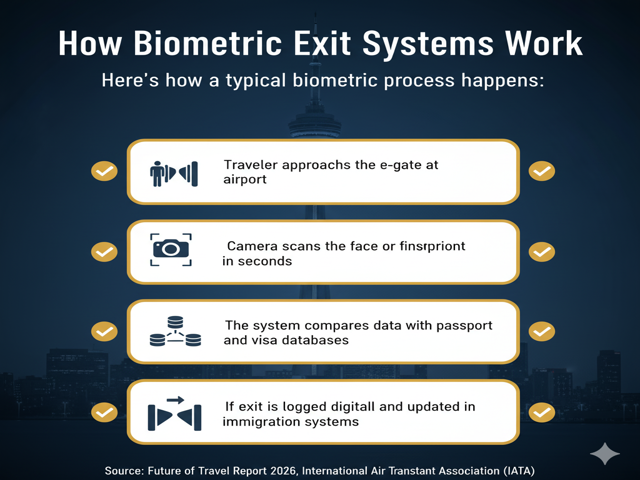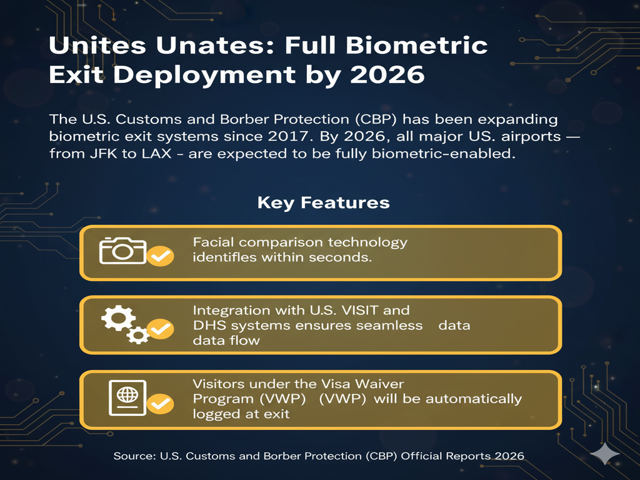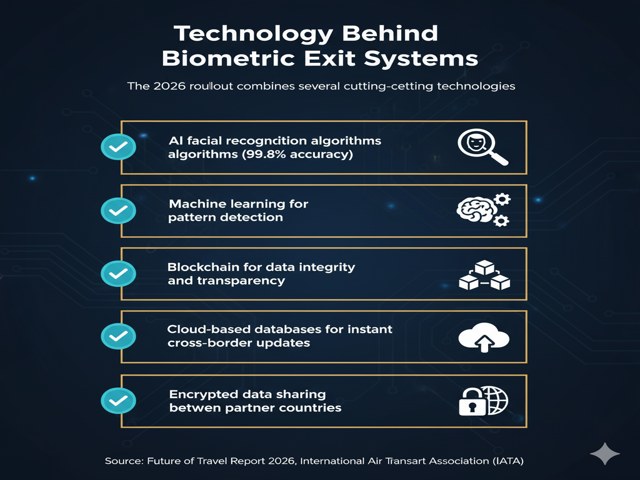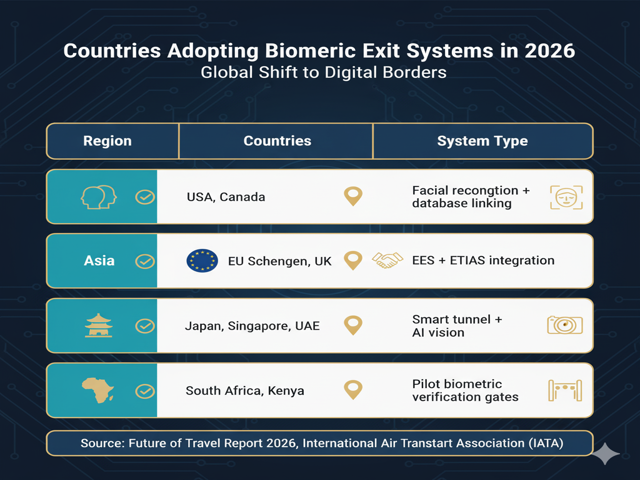The Smart Future of Global Travel
Biometric Exit Systems 2026 mark a revolutionary leap in how countries manage border security, immigration, and passenger flow. From the United States to the European Union, biometric verification is becoming the new global standard.
But what exactly are these systems? How do they work? And most importantly — what do travelers need to know to stay compliant in 2026 and beyond?
This detailed guide breaks down everything — from how biometric exit systems function to the countries leading the rollout, and what benefits, risks, and privacy concerns travelers should be aware of.
What Are Biometric Exit Systems 2026?
A Biometric Exit System (BES) is a digital immigration checkpoint that uses unique physical traits — like facial recognition, fingerprints, or iris scans — to verify a traveler’s identity during departure.
Unlike traditional passport stamping, these systems automatically:
- Capture a traveler’s image
- Match it against official records
- Record the exit from the country
- Share data securely with immigration authorities
The goal? Speed, security, and accuracy — reducing manual errors and improving global tracking of overstays.
How Biometric Exit Systems 2026 Work
Here’s how a typical biometric exit process happens:

- Traveler approaches the e-gate at the airport.
- Camera scans the face or fingerprints in seconds.
- The system compares data with passport and visa databases.
- If verified, the traveler passes through automatically.
- The exit is logged digitally and updated in immigration systems.
This process takes under 10 seconds, making it far faster than manual border checks.
United States: Full Biometric Exit Systems 2026 Deployment
The U.S. Customs and Border Protection (CBP) has been expanding biometric exit systems since 2017. By 2026, all major U.S. airports — from JFK to LAX — are expected to be fully biometric-enabled.

Key Features:
- Facial comparison technology identifies travelers within seconds.
- Integration with U.S. VISIT and DHS systems ensures seamless data flow.
- Visitors under the Visa Waiver Program (VWP) will be automatically logged at exit.
European Union: The EES and ETIAS Revolution
Europe is not far behind. The EU Entry/Exit System (EES) and ETIAS will go fully operational by 2026.
Every non-EU traveler will have:
- Facial and fingerprint scans upon entry and exit.
- Real-time tracking for visa overstays.
- Data shared across all Schengen Area countries.
This means easier, faster, and safer travel across France, Germany, Spain, and Italy — all without repeated passport checks.
Asia Leads with Smart Airports
Countries like Singapore, UAE, and Japan are pioneers in smart biometric travel:
- Singapore’s Changi Airport offers full contactless travel via facial recognition.
- Dubai International Airport uses AI-powered smart tunnels for automated border clearance.
- Japan integrates biometric data into My Number cards for seamless travel identity verification.
These nations prove that biometric exit systems can enhance tourism efficiency while maintaining national security.
Benefits for Travelers
Why should travelers welcome these systems?
Because they make traveling smoother and smarter.
Top Benefits:
- Faster border clearance — no more long queues.
- Accurate identity verification — reduced document fraud.
- Secure global tracking — helps prevent illegal overstays.
- Seamless integration — works across countries.
- Supports contactless travel — a post-pandemic essential.
Technology Behind Biometric Exit Systems
The 2026 rollout combines several cutting-edge technologies:

- AI facial recognition algorithms (99.8% accuracy)
- Machine learning for pattern detection
- Blockchain for data integrity and transparency
- Cloud-based databases for instant cross-border updates
- Encrypted data sharing between partner countries
Together, these create a global ecosystem of intelligent border management.
Privacy and Ethical Concerns
Of course, global rollout raises valid privacy questions:
- Who owns your biometric data?
- How long is it stored?
- Can it be misused by third parties?
The EU’s GDPR laws and the U.S. Privacy Act impose strict controls. Most systems now store encrypted templates rather than actual biometric images — reducing risk dramatically.
Countries Adopting Biometric Exit Systems 2026

| Region | Countries | System Type |
|---|
| North America | USA, Canada | Facial recognition + database linking |
| Europe | EU Schengen, UK | EES + ETIAS integration |
| Asia | Japan, Singapore, UAE | Smart tunnel + AI vision |
| Oceania | Australia, New Zealand | Digital identity passports |
| Africa | South Africa, Kenya | Pilot biometric verification gates |
By the end of 2026, over 65 countries are expected to have operational biometric exit systems at major airports.
How Travelers Should Prepare for Biometric Exit Systems 2026
To avoid complications, here’s what travelers should do:
- Renew passports early if near expiry.
- Check e-gate compatibility (some require e-passports).
- Arrive earlier during the first few months of rollout.
- Stay informed through official travel websites.
- Consent to scans — refusal might lead to manual inspection.
Source: International Air Transport Association (IATA) – One ID Initiative
Traveler FAQ: Biometric Exit Systems 2026
Q1: Do I need to register for biometric exit systems?
No. If your country or airport uses them, the process is automatic at departure.
Q2: What if the system fails to recognize my face?
You’ll be redirected to a manual inspection desk for verification.
Q3: Are these systems safe for privacy?
Yes. Most use encrypted data and comply with privacy laws like GDPR and CCPA.
Q4: Will biometric exit systems replace passports?
Not yet — but by 2030, digital identity passports may replace paper-based systems.
Q5: Which countries have the most advanced systems?
The U.S., Singapore, UAE, Japan, and EU are leading with advanced AI verification.
Read More: Schengen Visa Digitalization 2025: Online Applications & New Rules
Agent Advise: The Future of Border Control
The Biometric Exit Systems 2026 rollout is a major step toward a smart, seamless, and secure travel world. While privacy and technical issues remain, the benefits — faster processing, stronger security, and reduced human error — far outweigh the drawbacks.
Travel in 2026 will be defined by speed, safety, and simplicity, as AI and biometrics reshape the way we move across borders.



